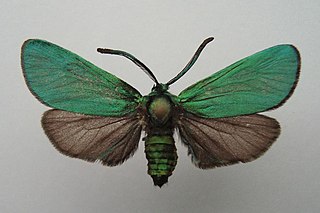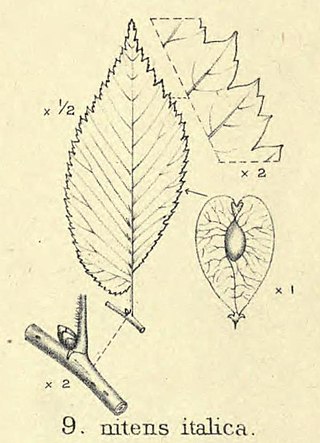
Legio I Italica was a legion of the Imperial Roman army founded by emperor Nero on September 22, 66. Originally named Legio Phalanx Alexandri Magni, it was stationed in Italy during the year of four emperors and gained the name Italica. It was later stationed at Novae, near modern-day Svishtov (Bulgaria). There are still records of the I Italica on the Danube border at the beginning of the 5th century. The emblem of the legion was a boar.

Legio II Italica was a legion of the Imperial Roman army.

Legio III Italica was a legion of the Imperial Roman army founded in 165 AD by the emperor Marcus Aurelius for his campaign against the Marcomanni tribe. The cognomen Italica suggests that the legion's original recruits were drawn for the defence of Italy. The legion was still active in Raetia and other provinces in the early 5th century.

The Zygaenidae moths are a family of Lepidoptera. The majority of zygaenids are tropical, but they are nevertheless quite well represented in temperate regions. Some of the 1000 or so species are commonly known as burnet or forester moths, often qualified by the number of spots, although other families also have 'foresters'. They are also sometimes called smoky moths.

Populus nigra, the black poplar, is a species of cottonwood poplar, the type species of section Aigeiros of the genus Populus, native to Europe, southwest and central Asia, and northwest Africa.

Italica was an ancient Roman city in Hispania; its site is close to the town of Santiponce in the province of Seville, Spain. It was founded in 206 BC by Roman general Scipio as a colonia for his Italic veterans and named after them. Italica later grew attracting new migrants from the Italian peninsula and also with the children of Roman soldiers and native women. Among the Italic settlers were a branch of the Gens Ulpia from the Umbrian city of Tuder and a branch of the gens Aelia from the city of Hadria, either co-founders of the town or later migrants who arrived at an unknown time; they were the respective stirpes of the Roman emperors Trajan and Hadrian, both born in Italica.

The Italian stream frog, also called the Italian frog, is a species of frog in the family Ranidae. The species is endemic to Italy and San Marino.

Adscita statices, the green forester, is a moth of the family Zygaenidae. It is found in Europe, Mongolia and western Russia.

Adscita is a genus of moths of the family Zygaenidae.

The Cross Internacional de Itálica is an annual cross country running competition that is held every January in Santiponce, near Seville, Spain. Inaugurated on December 19, 1982, the race course is set in the ruins of the ancient Roman city of Itálica. As one of only two Spanish competitions to hold IAAF permit meeting status, it is one of the more prestigious races on the Spanish cross country circuit.
Adscita albanica is a moth of the family Zygaenidae. It has a disjunct distribution, which included south-eastern France, Switzerland, in Italy, Slovenia, North Macedonia, Albania, Bulgaria, Greece, Ukraine, the southern part of European Russia and the Caucasus.
Adscita mauretanica is a moth of the family Zygaenidae. It is found in Morocco and north-western Algeria
Adscita krymensis is a moth of the family Zygaenidae. It is only known from the Crimea
Adscita capitalis is a moth of the family Zygaenidae. It is found in North Macedonia, Greece and Turkey.

Adscita alpina is a moth of the family Zygaenidae. It is found in Central Europe.

Adscita geryon, the cistus forester, is a moth of the family Zygaenidae. It is found in southern and central Europe, east to Turkey. It is also present in Great Britain.
Adscita obscura is a moth of the family Zygaenidae. It is found in Bulgaria, the Republic of Macedonia, Albania and Greece, as well as in Turkey, Iran, Russia, Transcaucasia, Syria, Lebanon, Israel and Egypt.

Adscita mannii is a moth of the family Zygaenidae. It is found in Germany, France, Switzerland, Austria, Italy, Spain, Slovenia and the Balkan Peninsula. The range extends to north-western Turkey.

Ulmus minorvar.italica was first described by Augustine Henry in 1913, as a 'variety' of field elm from Italy, Spain, Portugal and Algeria. He called it Ulmus nitens var. italica, 'Mediterranean Elm'. The variety was accepted by Krüssman (1984), despite the wide source-area claimed for it, as a non-clonal cultivar, U. carpinifolia var. italicaHenry. Bean (1988), however, considered it "a variety of rather dubious standing", and it was ignored by Richens (1983), who listed instead a "small-leaved U. minor of Spain" and a "narrow-leaved U. minor of northern and central Italy", as well as "the densely hairy leaved U. minor of southern Italy", the latter being Ulmus minor subsp. canescens, formerly Melville's Ulmus canescens.













